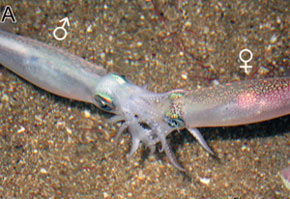

In a study on squid, researchers from the USP Biosciences Institute uncover the complex process of sperm transfer from males to females
In a study on squid, researchers from the USP Biosciences Institute uncover the complex process of sperm transfer from males to females.
In a study on squid, researchers from the USP Biosciences Institute uncover the complex process of sperm transfer from males to females.

In a study on squid, researchers from the USP Biosciences Institute uncover the complex process of sperm transfer from males to females
By Karina Toledo
Agência FAPESP – In a cover article published in the Journal of Morphology, researchers from the Universidade de São Paulo Biosciences Institute (IB-USP) described details that until now had remained obscure about the reproductive processes of cephalopod mollusks, the class of marine animals to which octopi, squid, cuttlefish and nautiluses belong.
The study was conducted with squid of the species Doryteuthis plei collected along the São Sebastião shoreline in São Paulo State. It was part of the doctoral studies of FAPESP scholar José Eduardo Amoroso Rodriguez Marian under the direction of Professor Osmar Domaneschi (in memoriam) and Professor Sônia Godoy Bueno Carvalho Lopes.
“Squid and the other cephalopods enter their reproductive phase at the end of the life cycle. During copulation, the males transfer their gametes to the females via a modified arm known as the hectocotylus,” said Marian.
The researcher explained that sperm are transferred inside capsules called spermatophores. These structures are continually produced by the male when he reaches sexual maturity and are stored in the spermatophoric sac. Dozens of capsules are transferred to the female during each copulation.
“We already knew about this process, but it wasn’t known why the cephalopods had such complex spermatophores. Some authors believe they are the most complex reproductive structures in the whole animal kingdom,” said Marian.
When he realized there was a lack of work in the area, Marian decided to focus his doctoral studies, which he had begun with a broader focus, on the understanding of the structure and function of the spermatophores.
“It was previously believed that the males performed a more active role in sperm transfer. But we showed that the spermatophore alone is able to anchor itself onto the female, perforate the tissue and glue itself on by releasing adhesive substances. This whole process is autonomously performed, in other words, by the spermatophore itself and extracorporeally,” he explained.
The spermatophore has three main components, each with its own distinct function. “Aside from the spermatic mass, which contains the spermatozoids, there is an ejaculatory apparatus, responsible for anchoring onto the body of the female and scarifying the tissue. And then there is the cementing body, the structure that liberates adhesive substances,” said Marian.
In the article published in the Journal of Morphology, Marian describes in detail the so-called spermatophoric reaction—the process during which the ejaculatory apparatus is projected and the spermatic mass and the cementing body are liberated.
The duration of this phenomenon varies according to species. The squid studied needed approximately 30 seconds. “But in the case of the giant Pacific squid, whose spermatophores can be a meter long, the process can take an hour,” he remarked.
To better understand each stage of the process, with the help of his colleagues at the USP Marine Biology Center Marian removed the spermatophores from the squid, prepared the in vitro spermatophoric reaction and observed the phenomenon under the lens of a microscope.
“The spermatophore is an elongated capsule, approximately a centimeter long in most squid. At one end, there is a filament. When this filament is pulled, it initiates the spermatophoric reaction,” he said.
The study also led to other publications; a detailed morphological analysis of the spermatophores was published in the journal Acta Zoologica.
The finding that spermatophores are able to perforate the tissue of the females led to an article in the Journal of Molluscan Studies. Another article reviewing the same subject was released in Papéis Avulsos de Zoologia.
“Based on the evidence we were able to gather, we developed a theoretical model to explain the spermatophore implantation process, a phenomenon that had remained obscure for a very long time,” stated Marian. The model was published in the Biological Journal of the Linnean Society.
“These animals are continually swimming by jet propulsion, and there is a great deal of turbulence on the surface of their bodies. Theoretically, this makes deposition of spermatophores difficult. The system of fixation by implant observed in the cephalopods is efficient because it can withstand the resistance resulting from the way these animals live,” said Marian.
Aside from FAPESP support, the project was funded by the Capes Post-Graduation Support Program (PROAP), the USP Post-Graduate Dean’s Office, the American Malacological Society and the Houston Conchology Society.
The study received four awards offered by societies of malacology (the branch of biology that studies mollusks): the American Malacological Society, the Houston Conchology Society, Unitas Malacologica and the Brazilian Malacology Society.
Republish
The Agency FAPESP licenses news via Creative Commons (CC-BY-NC-ND) so that they can be republished free of charge and in a simple way by other digital or printed vehicles. Agência FAPESP must be credited as the source of the content being republished and the name of the reporter (if any) must be attributed. Using the HMTL button below allows compliance with these rules, detailed in Digital Republishing Policy FAPESP.




